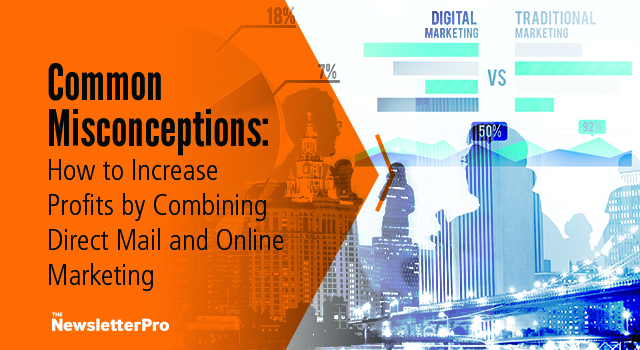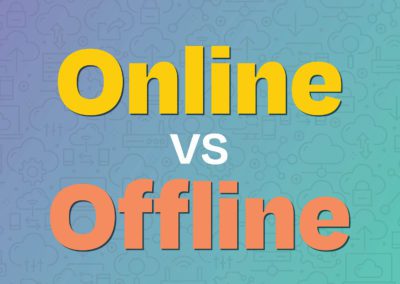
It seems like a lot of attention is being paid to online marketing strategies in 2016, but the traditional marketing method of direct mail is as important as ever. If you’re focusing only on online marketing, you’re leaving some very powerful marketing opportunities on the table in the form of postcards, newsletters, flyers, catalogues, and more. But it’s impractical to succeed without an online presence either.
So rather than looking at online marketing versus direct mail as competing with each other, it’s time to start looking at them is complimentary — a way to reinforce each other and unify your brand message and strategy. There are countless ways to see the two working in sync.
Online Marketing Informs Your Direct Marketing Buyer Persona
What do you know about your audience? If you have an active online presence, chances are good that you have a wealth of data at your disposal. Consider your social media engagement statistics: Which of your posts, links, and ads attracted the most attention? Take note of the topic, wording, and images that got the best response.
Another great feature of social networks like Facebook and YouTube is the ability to dig deeper into demographic information. You can find out the age, gender, location, and interests of your audience — all of which can be included in buyer personas for your audience. From there, you segment your audience and target each segment with hyper-relevant, timely direct mail offers.
Online marketing data is a powerful source of information to use in your direct mail campaigns.
Online Social Proof in Your Direct Mail
Make direct mail more effective by pulling information from social media to support your brand credibility. The reason is simple: According to Nielsen, 84 percent of consumers say they trust recommendations from family, colleagues, and friends. People trust their peers a lot more than they trust advertising, and your online marketing efforts can provide you with plenty of social proof for direct mail pieces.
Here’s an example. If your Facebook page has 3,300 likes, you can include a social share button in your direct mail piece and a little blurb that says “Join thousands of other fans.” You could embed a tweet graphic from someone who said positive things about your business on Twitter. If you have an offer, you can reveal how many times it’s been downloaded, commented on, or shared, using engagement statistics. These numbers tell prospects that you’re the real deal, which will improve the response rate on your direct mail campaign.
Cross-Promotion
In your direct mail piece, consider including a link to a corresponding landing page, possibly through a QR code or a personalized URL. You’re accessing a different crowd than you would see with online marketing alone, and you’re still taking full advantage of your online infrastructure along the way. Direct mail is able to reach the right audience and turn them into qualified leads you can then guide through your online marketing funnel.
Conversely, you can use social media or email to announce that a special offer will be coming in the mail. You can encourage recipients to share the direct mail offer on their own social media profiles (or with their real-life network) — and, similar to the use of tweets or Facebook post images in your direct mail pieces, you can post images of your direct mail pieces on social media to build up the hype!
Credibility and Trust
Let’s face it — there’s a lot of scamming on the Web. How comfortable are you buying from someone you’ve only had contact with online? While it’s getting more acceptable than it used to be, there’s still a lot of reluctance on the part of consumers to give their credit card information to an online-only business.
![]() Many people still feel like you’re not a real business if you have no offline presence. If you rely on e-blasts and a website alone, you’re alienating a portion of the audience who would welcome direct mail. The fact is, direct mail makes your business seem a lot more credible than a series of emails does.
Many people still feel like you’re not a real business if you have no offline presence. If you rely on e-blasts and a website alone, you’re alienating a portion of the audience who would welcome direct mail. The fact is, direct mail makes your business seem a lot more credible than a series of emails does.
The reverse is true as well. We’re likely to be a little suspicious or wary of businesses that send out direct mail but have no Web presence. When the two work in tandem, the synergy adds serious credibility to your business operation. In fact, 76 percent of small businesses state that their ideal marketing strategy encompasses a combination of both print and digital communication to increase conversions (Pitney Bowes, 2015). The proof is in the numbers!
Think Holistically
By analyzing the customer journey, you can point offline direct mail prospects to your online media at the right stage for them — whether that’s to make a purchase or just find out more information. Think holistically about how each piece of your overall marketing strategy can feed into increasing sales and profits. All the pieces you need to solve this puzzle are there — now it’s time to put them in place, convert more prospects to customers, and experience sustainable business growth.







